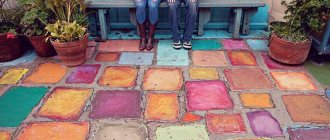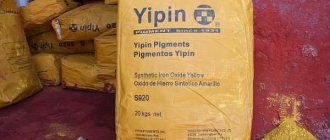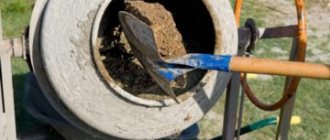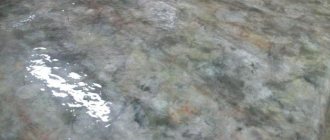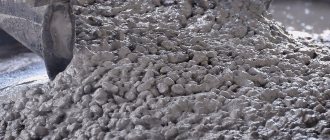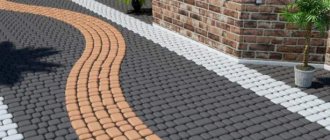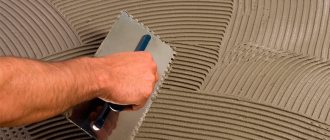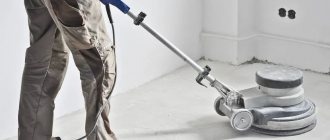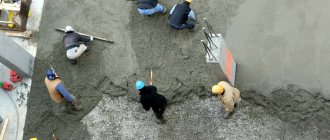Until recently, the nondescript surface of concrete served as a background that needed to be decorated with various finishing materials. Today there is no need for this, since an innovative mixture has appeared that can replace existing methods of decorative finishing. Acid dye for concrete is a unique solution that allows you to change the color of the floor, wall, and easily transfer the exact pattern without wasting finishing materials. The construction market of Moscow, St. Petersburg and other CIS cities offers a decent option for concrete coating with acid dye.
How does acid dye work?
The principle of action of paint on the surface of concrete is the interaction of each component of the mixture with hydrated lime. A concentrate of acid and metal salts diluted in a certain proportion with water is called an acid dye for concrete surfaces.
The chemical components are selected so that, penetrating into the pores of concrete, they cause a reaction between colored pigments and hydrated lime. The result is a rough coating with a unique pattern.
Inorganic salts react chemically with minerals and penetrate to a certain depth in the concrete slab. After hardening, a pattern remains on the open plane, which does not wear out until the concrete layer is erased. In hardened cement, calcium hydroxide interacts with a salt composition that is highly soluble in water, and the acid serves as a solvent for the contaminated layer and a “conductor” through which the active components are connected. As a result, paving slabs or walls do not have a glossy film or characteristic shine. The acid dye is mixed with the concrete filler, so the dissolved pigment does not retain a bright shade. Due to the rough texture, the coating looks as natural, neat and beautiful as possible.
Blue tones
| Aqua | #00FFFF | 0, 255, 255 |
| Cyan | #00FFFF | 0, 255, 255 |
| LightCyan | #E0FFFF | 224, 255, 255 |
| PaleTurquoise | #AFEEEE | 175, 238, 238 |
| Aquamarine | #7FFFD4 | 127, 255, 212 |
| Turquoise | #40E0D0 | 64, 224, 208 |
| MediumTurquoise | #48D1CC | 72, 209, 204 |
| DarkTurquoise | #00CED1 | 0, 206, 209 |
| CadetBlue | #5F9EA0 | 95, 158, 160 |
| SteelBlue | #4682B4 | 70, 130, 180 |
| LightSteelBlue | #B0C4DE | 176, 196, 222 |
| PowderBlue | #B0E0E6 | 176, 224, 230 |
| LightBlue | #ADD8E6 | 173, 216, 230 |
| Sky Blue | #87CEEB | 135, 206, 235 |
| LightSkyBlue | #87CEFA | 135, 206, 250 |
| DeepSkyBlue | #00BFFF | 0, 191, 255 |
| Dodger Blue | #1E90FF | 30, 144, 255 |
| CornflowerBlue | #6495ED | 100, 149, 237 |
| MediumSlateBlue | #7B68EE | 123, 104, 238 |
| RoyalBlue | #4169E1 | 65, 105, 225 |
| Blue | #0000FF | 0, 0, 255 |
| MediumBlue | #0000CD | 0, 0, 205 |
| Dark Blue | #00008B | 0, 0, 139 |
| Navy | #000080 | 0, 0, 128 |
| MidnightBlue | #191970 | 25, 25, 112 |
Instructions for painting concrete with acid dyes
Acid paint for concrete contains hazardous components. The application process is accompanied by the evaporation of harmful substances into the air.
- According to the instructions, the coating is heated to 30-45 0C, so you need to work strictly following safety rules.
- For work, wear a special rubberized uniform, since when it spreads over the surface being treated, splashes fly, and the composition contains acid, alkali or salt.
- Prepare ingredients and mix solutions in plastic buckets with wide sides.
- For application, use special equipment, power tools and personal protective equipment.
Characteristics of anti-acid coatings
Please note that all technical requirements for acid-resistant paints and varnishes are set out in a document such as GOST 7313-75.
Acid-resistant compositions have the following characteristics:
- This type of paint material is based on a mixture of two types of resins - polyvinyl chloride and alkyd. Such components are diluted with organic solvents. Pigmenting substances and also plasticizers are used as additives - they will improve the characteristics of the material and also increase the resistance of protective coatings in the external environment.
- The finished solution is intended for use only as part of a complex protective coating. In other words, if you paint unprepared surfaces with such paint, the manufacturing company refuses to guarantee the preservation of the declared commercial properties.
- The acid-resistant composition can be used to paint a wide variety of materials, including concrete, metals, and plastered surfaces. Paint and varnish material is used both for painting the interior parts of buildings and for facades.
- When the painted surface dries and it receives all the characteristics specified by the manufacturer. But it is worth considering that anti-acid paints and varnishes lose their quality at temperatures above +60 degrees Celsius.
- Acid-resistant products should only be applied by spraying. Rollers and brushes are not used to work with such paint.
Preparing the surface for acid painting
The process of applying a coat of paint to a concrete slab begins with preparing it. In order for acid dyes intended for concrete to be well absorbed and retain color, the following preparatory measures must be carried out.
- Concrete is cleaned of debris, dust, heterogeneous inclusions - sawdust, crumbs or small fragments of plaster, grease-containing oil stains, hardened sealant or glue are washed off.
- The strength of the layer is checked by driving in a nail. The appearance of cracks indicates that the solution was excessively liquid. The low-strength top layer, where water usually accumulates, is removed using a grinder.
- The old slab is leveled. If the concrete is sufficiently worn, fragments of filler (crushed stone, sand) are visible that do not react with the dye solution. If there are no lime inclusions in the surface layer due to depletion, then the expected chemical reaction will not occur during the painting process.
- Cracks and small holes are sealed with putty.
- When thoroughly cleaning, it is not recommended to use products containing trisodium phosphate, as this substance seals the pores of the lime component. As a result, the paint will not be absorbed in a beautiful, uniform layer.
- Determine the brand of cement used. It should not contain foreign impurities or additives.
- To enhance the chemical reaction, the method of etching concrete is used.
If the concrete is fresh, then begin painting the concrete after at least two weeks have passed.
Concrete etching equipment
The process of working with a chemical composition, therefore, to comply with safety precautions, you need to use tools and devices:
- safety glasses and a respirator that protects against harmful fumes;
- spray bottles;
- boots or boots with studded soles, allowing you to move without restrictions on the painted surface;
- in small areas you can work with a paint brush;
- sponge or sponge smoother;
- long-handled brush with acid-resistant nylon bristles;
- non-leak containers for dye and for preparing a solution made of plastic with wide edges;
- equipment for washing at the preliminary and final stages;
- cleaning of the horizontal plane is carried out using a rotary machine;
- flushing hose with ventilation;
- spray gun type for working solution.
The specified list of auxiliary devices is enough to do the job accurately and quickly. It is not necessary to use washing equipment for cleaning. You can clean the floor in the room with a regular mop, and water the path outside with a hose with high water pressure. If you work indoors, safety glasses and a respirator will not be enough. During the chemical etching process, if possible, open the window and ventilate the room or turn on forced ventilation.
Structures
The chemical composition of acid dyes is complex and varied. Most acid dyes are related in their basic structure to the following:
- Anthraquinone Type:
Many acid dyes are synthesized from chemical intermediates that ultimately form anthraquinone-like structures. Many blue dyes have this structure as their main form. The structure predominates in the class of leveling acid dyes. - Azo dyes:
Azo dyes contain azo dye (RN = NR. Most azo dyes are not acid dyes, but many acid dyes are azo dyes. Many azo type acid dyes are red in color.[14] - Triarylmethane dye:
They predominate in the class of milling dyes. There are many yellow and green dyes that are commercially applied to triphenylmethane-related fibers.
- CI Acid black 1
- CI Acid yellow 36
- CI Acid Blue 117
- CI Acid Orange 19
- CI Acid blue 25
- CI Acid Orange 3
Application of acid dye
The concentration of the tint composition on the plane depends not only on the proportion of the pigment, but also on the method of applying the mixture. When working, a plastic spray gun is used, from which a solution is sprayed under pressure. The power tool must be suitable for working with acidic compounds. To achieve a rich, thick shade, paint is applied with a brush. After it, traces of strokes remain noticeable, so you need to go over the surface being treated again using a pump sprayer until they completely disappear.
To achieve the “marble” effect, the concrete slab is placed at a slight slope and paint is liberally applied. As a result, self-distributed acid dyes for concrete form an irregular pattern, imitating an expensive material. To form a natural pattern with veins, two mixtures are used:
- strong concentration - a rich, bright color is obtained;
- weak concentration - a light, bleached shade is obtained.
First, apply dark paint, then, without waiting for it to dry, apply a light mixture in thin streams. When it begins to spread on its own, simple patterns are obtained in the form of visible veins of concentrated dark paint. A multi-colored coating is obtained as a result of alternating and applying compositions of different shades.
Brown acid concentrate of the walnut brand is a dye for a decorative change of shade on concrete flooring and paving slabs. Artificial stone, as well as other products with a cement component, are perfectly painted in a dark brown color. The composition creates the effect of a natural natural coating. Over time, the paint does not fade or fade; the paint fixed with varnish is not washed out by water. Penetrating deep into the concrete layer, it does not peel off from the rough relief plane during its service life.
Two-component formulations
Recently, two-component compositions that combine epoxy paints and hydrocarbon resins have become increasingly popular.
Paintwork materials of this type are characterized by the following qualities:
- The components are offered separately, so they must be mixed before painting. Moreover, it is necessary to achieve complete homogeneity of the composition, otherwise the properties of the coating will be worse than they could be. It is recommended to mix the components using a drill with a mixer installed on it. It is better to stir the mixture at low speeds so as not to splash the liquid.
- Two-component compositions can be applied not only with a spray, but also with a brush or roller. The choice of a specific method of surface treatment is dictated by the tasks set and the volume of painting.
- The paint and varnish composition should be applied using protective agents. You will need a gown, gloves and a respirator. If you do not take care of safety, paint that gets on the skin can cause irritation or allergies.
- About a day after painting, the coating dries and is ready for use in adverse external conditions.
Note! Surfaces painted with anti-acid paints can be washed using detergents. This will not damage the base or change its performance.
What factors affect the color of acid staining?
The color of the surface to be painted in most cases depends on the concentration of the solution and the method of applying the composition to the slab being treated.
The interaction of chemical components depends on several factors:
- If additives are included in the concrete solution.
- The quality of cement, as well as the ratio of the working mixture.
- Silicon or granite crushed stone is resistant to the innovative paint composition. If they are included in the working batch, the coloring of the concrete will be uneven - fragments of stones will stand out against the general background and interfere with the normal course of the chemical reaction.
- The total ambient humidity at the time of painting, the ratio of dry matter and water in the concrete slab.
Before starting work, it is recommended to do a test to check how uniform and high-quality the updated coating will be. It may be necessary to increase the concentration of some components and reduce the percentage of others to obtain a bright shade.
Neutralization of the surface and removal of acid dye reaction residues
After drying, the completed reaction with the acid dye brings a precipitate to the surface as by-products. Unused dye remains at the top. Chemical elements must be removed or neutralized with soda.
- An aqueous solution of 5 tbsp. soda per 10 liters of liquid. Using a brush with soft bristles, distribute the water over the entire surface, then carefully collect it with a cloth.
- Wash again with clean water. For these two stages, it is advisable to use a washing vacuum cleaner if the cleaning is carried out indoors. If the painting process takes place outdoors, then it is convenient to use a hose with a sprayer and strong water pressure to remove byproducts of a chemical reaction.
- Clean paving slabs on a garden path or a flat floor or wall are left until completely dry.
Surface treatment with hardening impregnation
At this stage, the concrete is treated with a special compound that secures the applied layer of paint. High-quality impregnation creates an invisible film and guarantees the preservation of brightness and depth of shade. Impregnation not only affects the color component of the renewed coating, but also strengthens the porous structure.
A protective layer with a polymer or inorganic base increases the guaranteed service life. Epoxy resins and polyurethane contained in the impregnation structure the top layer with a lime component.
- Impregnation helps to withstand sudden temperature changes.
- Strengthens the structure for resistance to chemical and mechanical stress.
- Helps remove natural concrete dust.
Details about paintwork
Priming with varnish composition
Before painting the surface, it should be primed; for paint XB-785, the varnish composition XB-784 is used as a primer. The characteristics of such a varnish product, as well as its quality parameters, are determined by the provisions of GOST 7313-75. The use of a primer varnish composition makes it possible to strengthen the base and also achieve ideal adhesive properties of the coating. It is priming that will ensure the reliability of the protective coating and makes it possible to extend its service life.
Two-component products
Recently, two-component products that combine epoxy paints and hydrocarbon resins have become increasingly popular. Paintwork materials of this type are characterized by the following qualities:
- The components of acid-resistant paint for battery rooms are offered separately and should therefore be mixed before painting. In this case, it is necessary to achieve complete homogeneity of the composition, since the properties of the coating will be much worse than they could be. It is recommended to mix the components using a drill with a mixer installed on it. It is better to stir the mixture at low speeds so as not to start splashing the liquid.
- Two-component products can be applied not just with a spray, but also with a roller and brush. The choice of a specific surface treatment method will be dictated by the tasks at hand and the amount of paint.
- The paint-type composition should be applied using protective agents. You will need a respirator, gown and gloves. If you do not think about safety, paint and varnish material that gets on the skin can cause allergies or irritation.
- Approximately 24 hours after painting, the coating will dry and be ready for use in adverse external conditions.
Please note that surfaces painted with anti-acid paints can be washed using detergents. This will not damage the base or change its characteristics.
Features of performing work with paints
When performing work, you should adhere to a number of rules:
- Acid-resistant paints for wall surfaces must not be diluted with foreign ingredients. This will negatively affect the quality of the coating.
- His weather forecast will call for rain and work should be cancelled. According to technological requirements, the surface must dry without direct contact with water.
- Painting should only be done on a dry surface.
- The base should not be dirty under any circumstances, and dust, debris and oil stains must be removed from it.
- The surface should not be loose. If this is the case, you need to either abandon painting or take measures to create a surface that will be much denser.
- Painting work can only be carried out in the recommended temperature mode - the maximum temperature is +30 degrees, and the minimum is +5 degrees.
The work is carried out in this order:
- The first step is to remove dirt from the surface.
- If the base is wet, it should be dried. If necessary, you can use a heat gun or a hair dryer.
- Painting is carried out in two layers, and this is the minimum requirement, because in certain cases three or four layers of paint may be required.
Let’s take a separate look at AntikorKhim paint.
Acid-resistant alkali-resistant paint "AntikorKhim"
There is not just XB-785 on the market, but also other types of anti-acid compounds. One of them will be the acid-resistant paint “AntikorKhim”, and as an example it is worth examining the characteristics of the specified paint and varnish material, as well as the features of its use
. "AntikorKhim" as an acid-resistant paint is used for painting the following types of surfaces:
- Baths made of metal structures, technological equipment, which during operation come into contact with alkaline and acidic environments.
- Tanks for storing and transporting petroleum products, alcohols and acids.
- Marine vessels, as well as hydraulic structures.
- Metal piles and piers.
- Metal structures that operate under increased load (handrails, steps, platforms, etc.).
Advantages of the paint and varnish material "AntikorChem":
- Resistance to aggressive external environments. The paint is specially adapted for use in difficult conditions. A distinctive feature of AntikorChem is a higher temperature threshold compared to its competitors - the coating will not lose its quality at temperatures up to +70 degrees.
- Drying speed and relatively low requirements for preparation work. The paint and varnish material dries within an hour, and it can be applied even to rusty surfaces.
- Versatility of use. The product has excellent adhesion characteristics in relation not only to rough steels, but also to galvanized and non-ferrous metals.
Metal paints that are resistant to aggressive environments, as well as other materials, are indispensable in construction and industry. Anti-acid agents place increased demands on compliance with the technological process. For this reason, before using such paints and varnishes, carefully read the instructions from the manufacturer.
Finishing with concrete varnish or wax
The last layer performs not only a protective, but also a decorative function. To consolidate the chemical reaction in the upper layers of the concrete coating, the varnish is applied after two to three days. The treated slab should dry well and ventilate. Wax emulsion or polymer varnish protects against daily wear and tear by creating a durable surface layer:
- on concrete fences;
- on cement paths;
- on construction floor screeds;
- in warehouse hangars;
- in car parks;
- on other concrete structures for industrial purposes.
Concrete surface filled with varnish, durable multi-layer construction due to the reflective properties of the chemical. There are glossy and semi-gloss, semi-matte and matte effects from the final varnish coating.
- The polyurethane composition is used to treat concrete surfaces and natural materials susceptible to the destructive effects of moisture.
- Silicone in the varnish guarantees a glossy finish.
- Acrylic is the most expensive component for concrete processing - it is used as decoration.
- Polymer varnish is used when painting large areas. It dries quickly, does not wear off during use and is cheap.
Varnish coatings are practically not subject to corrosion.
Priming with varnish
Before painting the surface, it must be primed. For XB-785 paint, XB-784 varnish is used as a primer. The characteristics of this varnish and its quality parameters are determined by the provisions of GOST 7313-75.
The use of primer varnish makes it possible to strengthen the base and achieve better adhesive qualities of the coating. It is priming that ensures the reliability of the protective coating and allows you to extend its service life.
How to make acid dye for concrete with your own hands
Knowing the composition of the paint and the technological sequence of the process of applying it, you can coat the concrete yourself without the help of specialists. The first method is to add a coloring pigment while mixing the working solution: cement, water, sand and acid paint in a certain proportion. The color extract is added to the dry mixture of cement and sand. Due to the high viscosity of the finished solution, water is poured after mixing. Cement is very dusty, so one of the disadvantages of the process is the need to mix the mixture dry. After adding water, a different shade is obtained; it is impossible to immediately predict the pigment concentration.
If you know how much powder to pour, then the option looks quite simple and has the following advantages:
- This method does not affect the operating technology.
- The color pigment is evenly distributed throughout the solution. There is no loss of shade even as a result of surface abrasion.
- The paint, as a result of chemical interaction, serves as an additional strengthening component.
The second method, which is more rational, involves applying a paint solution to finished road tiles or concrete slabs.
- This option allows you to economically use coloring pigment, which is not cheap.
- The tiles can be bought ready-made without acid pigment, and then painted with acid paint, resulting in a two-color concrete stone when viewed from the side.
- This method is available when processing old smooth surfaces or road tiles.
- The application of the coloring solution is carried out using simple devices.
For kneading you need:
- solvents;
- coloring pigment;
- fixatives;
- substance with an adhesive effect.
To make an acid dye for concrete yourself, you need to mix the components until the composition is homogeneous. We use chlorine as the basis of the mixture, for which we dissolve 1 kg of lime in a five-liter container filled with water. In another container, add half a kilogram of dye in small portions to water, dissolving evenly, and bring to a volume of 1 liter. Pour 250g of calcium chloride into the resulting paint. Grate laundry soap into a five-liter bucket of dissolved lime. The lime mixture and diluted paint with soap are combined and mixed until smooth, the paste is passed through a sieve.
Our acid and alkali resistant paint is used to protect:
- Technological equipment, baths of metal structures, the operation of which involves long-term or short-term contact with a solution of acids and alkalis;
- Tanks for storing petroleum products, acid solutions or alcohols;
- Marine vessels and hydraulic structures;
- Piers and metal piles;
- Structures operating under conditions of increased wear (metal steps, handrails, platforms, etc.);
- From exposure to the atmosphere
Galvanic method of applying metal coating
Electrolytes used in electroplating include various acids, which, when combined with elevated temperatures, can cause damage to the metal.
Let us consider the main technological stages of coating application, as well as the composition of the most dangerous solutions from the point of view of aggressive effects.
The main stages of coating application and the composition of the solutions used
As an example, we use the galvanizing process of metal. Galvanizing is especially often used in the production of fasteners and structures for construction.
The application of any coating on metal can be divided into three successive stages.
Stage 1 - preparing parts
In the case of zinc, the parts are first cleaned of rust, grease and dirt. After this, they are placed in a special washing bath. This is followed by another stage of metal cleaning - electrochemical degreasing, which also ends with washing. The preparatory stage ends with etching of products in acid solutions (sulfuric, hydrochloric, phosphoric, etc.)
Stage 2 - direct application of galvanic coating.
Pre-prepared products are hung on a special rod or holder and the process is started.
Stage 3 - additional coating processing
The final stage is the processes of clarification and passivation. These operations, along with etching, are of greatest interest because they are performed using acid solutions. In this case, the equipment is subjected to increased stress, so it is worth considering buying acid-resistant paint and carrying out work to protect it.
Let's consider the composition of solutions used in electroplating production:
| the name of the operation | Solution composition g /l | Temperature C | Processing time (min) | Processed material |
| Etching | Sulfuric/hydrochloric acid 100-150 | 20-60 | Up to 30 | Steel/copper |
| Caustic alkali 50-80 | 50 | 1 | Aluminum | |
| Picking | Sulfuric acid 700-850 | 15-25 | 1 | Steel |
| Chromic anhydride 150-250, sulfuric acid 1.5-2.5 | 45-50 | 1 | Steel before chrome plating | |
| Anodic oxidation | Sulfuric acid 200 | 15-25 | 20-30 | Aluminum |
| Copper plating | Copper sulfate 200-250, sulfuric acid 50-75 | 18-25 | — | For extension over copper or nickel sublayer |
As can be seen from the table, the greatest danger to metal parts of equipment is posed by pickling and pickling (activation) operations. In addition, baths intended for washing products can also be subject to corrosion.
Auxiliary structures and equipment of the electroplating shop requiring the use of special acid- and alkali-resistant paint
Auto operators - their operation does not involve direct contact with acid solutions, but they are still exposed to aggressive vapors formed above the surface of the solutions. Thus, only acid-alkali-resistant paints should be used for painting them. It’s easy to buy acid-resistant paint in Moscow. You can submit a purchase request by phone or email, and we will contact you.
